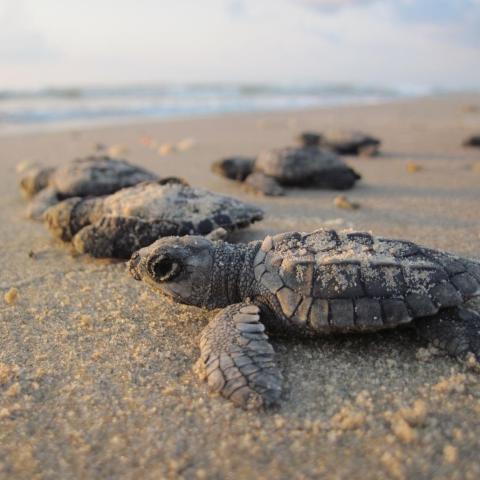
Mangrove forests that protect places such as Biscayne, Everglades, and Virgin Islands national parks could be gone by 2050/NPS, G. Gardner
Mangrove trees serve as nature's hurricane barriers for places such as Everglades National Park, Biscayne National Park, Virgin Islands National Park, and Big Cypress National Preserve. Plus, they provide valuable habitat for fish and other marine life, and are pretty cool for humans who are fortunate enough to paddle through them. But they could be gone by 2050, victims of sea level rise driven by climate change.
Scientists studying sediment data from the last 10,000 years are estimating that current projections for sea level rise will doom mangroves if they come true.
When sea level rise rates exceeded 6 millimeters per year, similar to estimates under high-emissions scenarios for 2050, the scientists found that mangroves were very likely to stop keeping pace with the rising water levels. Mangroves are more likely to survive when sea-level rise is less than 5 millimeters (about 0.2 inches) per year, which is projected for low-emissions scenarios this century, the study published in the journal Science said.
"Under high-emissions scenarios, rates of sea-level rise on many tropical coastlines will exceed 7 millimeters per year, the rate at which we concluded there's a 6.2 percent probability mangroves can sustain growth," said co-author Erica Ashe, a post-doctoral scientist in the Department of Earth and Planetary Sciences in the School of Arts and Sciences at Rutgers University-New Brunswick. "The loss of these mangrove ecosystems could result in increased carbon dioxide in the atmosphere and fewer vital buffers against storm surges in the long run."
There are about 80 species of mangrove trees, which grow in tropical and subtropical areas. Mangrove forests stabilize the coastline, reducing erosion from storm surges, currents, waves and tides, according to the National Oceanic and Atmospheric Administration. Mangroves' intricate root system makes the forests attractive to fishes and other organisms seeking food and shelter from predators. In the Florida Keys National Marine Sanctuary alone, mangroves line more than 1,800 miles of shoreline.
Many fish and shellfish, such as the grouper and stone crab begin their lives among the roots of the red mangroves, which serves as a nursery by protecting them from predators. Many wading birds such as the great blue heron and great egret also enjoy the safety the roots provide by using the red mangroves as a nesting and breeding ground. The tall, arching roots protect and stabilize the shoreline by trapping mud and sediment that gradually builds up over time. This help to protect the shoreline from erosion. -- Big Cypress National Preserve
The trees also slow water flow from the land into Biscayne Bay and allow sediment to settle, according to the National Park Service. "Leaves fall from mangrove branches year round. The leaves break down to become food for tiny marine organisms which, in turn, become food for larger organisms including commercially important species of fish, shrimp and lobster. Without healthy mangrove forests, Florida's vital recreational and commercial fisheries would drastically decline," notes the staff at Biscayne National Park.
At Virgin Islands Coral Reef National Monument, "(T)ucked among the roots and shade of the red mangrove trees is a stunning and colorful array of corals, sponges, anemones, and fish. The communities are remarkably diverse, rich in texture, color, and number of species. The diversity of corals may be unique among mangroves of the Caribbean."
The study covered 78 locations and explored how mangroves responded as the rate of sea-level rise slowed from more than 10 millimeters yearly 10,000 years ago to nearly stable conditions 4,000 years later. The storage of carbon as mangrove forests expanded during that period contributed to lower greenhouse gas levels.
Mangroves will naturally move inland if they can't build vertically, according to the researchers, but coastal developments along many coastlines already greatly impede such movement. The findings stress the importance of mitigating the magnitude of rapid sea-level rise and ensuring that coastal adaptation measures allow mangroves to expand across coastal lowlands.




 Support Essential Coverage of Essential Places
Support Essential Coverage of Essential Places






